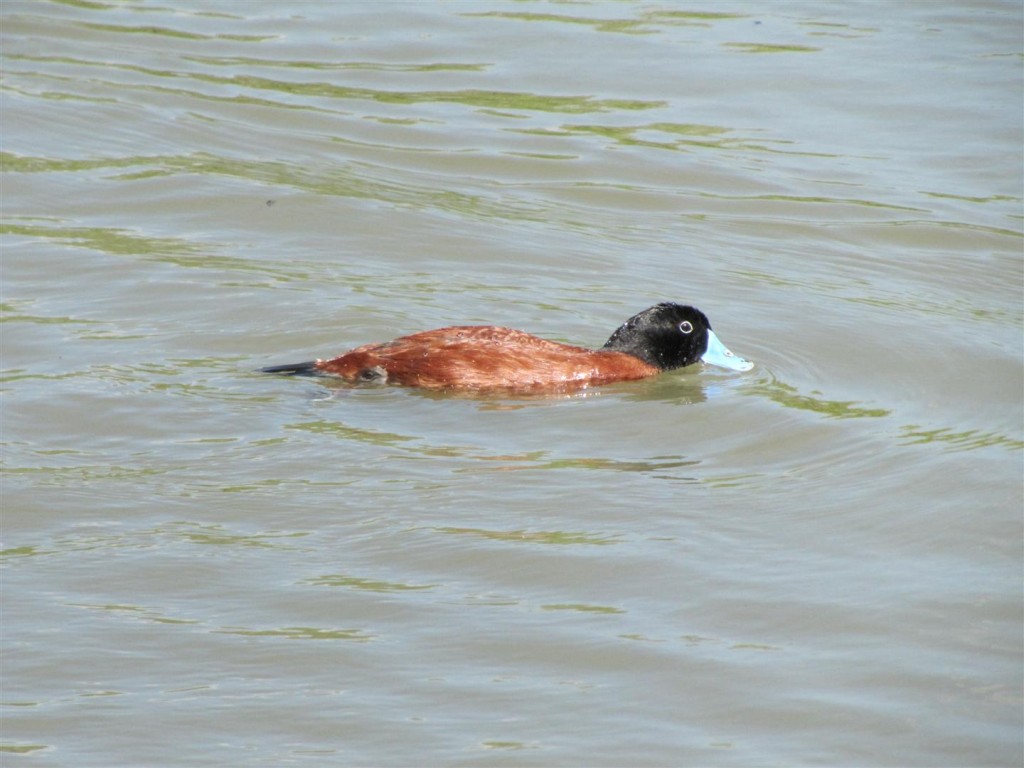Breeding Summary - Slimbridge 2015.
Duckery seasonal summary 2015: WWT Slimbridge Wetland Centre
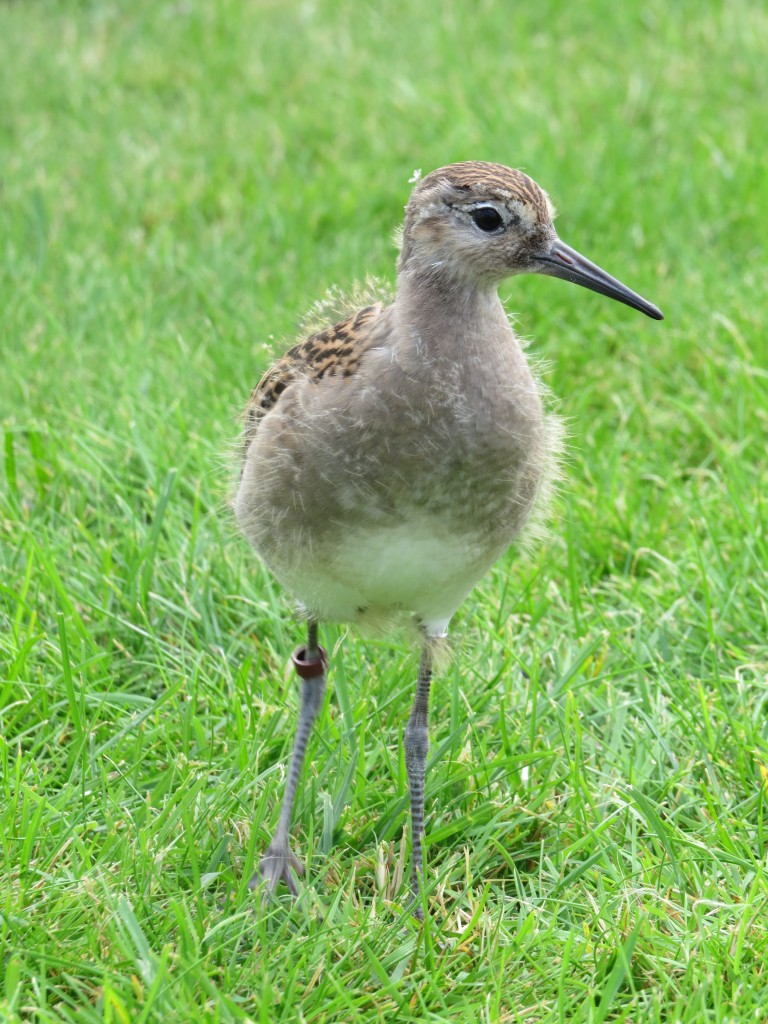
As many of you know, to guarantee purity and comfort we breed our wildfowl at WWT Slimbridge in bespoke purpose-built breeding pens off site at the Top Hut. Here the best of the breeds are observed and maintained with breeding in mind. As a result of this the future of a species in any given year can often depend on the power of the partnership between just two individuals. As a result we need to put in maximum effort regards our observational skills to assess whether our pairs work well together.
In 2015 we found ourselves with quite a large selection of the smaller wildfowl to breed, and so we invested a lot of time in our breeding aviary compositions. Due to the diversity of species types we keep, mixing them in a shared exhibit can prove difficult. This season we experimented with a selection of smaller teal and shoveler in the larger aviaries, to mixed success. Whilst they were very willing to breed, the quality of their nests was a barrier to success in some cases. Species such as the Koloa and NZ Shoveler had their nests flattened by some of the larger ducks if they were not sufficiently camouflaged. Despite these difficulties, excellent observation skills from our long-term seasonal Morwenna allowed for the collection of some “dumped” (abandoned) eggs in the early season. As a result of these efforts we have bred 2 exceptionally valuable Koloa (Hawaiian duck) despite their not having created a proper nest.
I was exceptionally grateful for the opportunity to visit the Sylvan Heights Bird Park in North Carolina this April for some species training. Huge thanks go to Mark, Leanna and the team for making it possible. We constantly strive to make the Duckery rearing area a success through constant observational improvement, and visiting such an illustrious collection was hugely beneficial. The SH collection is a purpose-built visitor centre created in the last 10 years to exhibit wildfowl for Conservation education. They have numerous walk-through exhibits where species are exhibited in the bright colours and toasty temperatures of the southern States. I witnessed Demoiselle cranes breeding within touching distance of the path, Roseate spoonbills doing their courtship displays, and Caribbean flamingos being hand-fed whilst incubating their eggs. As alien as these exhibits may seem to us as the moment, all individuals are just that; individuals. It was fascinating to witness what is possible with a thorough understanding of animal behaviour and the protection of an intelligent exhibit.
Flamingos:
Flamingo breeding preparations at Slimbridge were well under way early in the season as the team continued their exhibit improvements using Silica sand. All of the flamingo exhibits have now received silica sand due to its improvement of foot health and nest design properties. The flocks were also put onto their breeding rations much earlier this year, following on from the success of changing to Mazuri sinking pellets. With increased flock training from Phil (achieved through making reliable and observable routines) the temperaments of the flocks has also improved.
Due to so many changes occurring at once, unfortunately we will be unable to identify which of the alterations has made such a change to their breeding success. We will be unable to confirm whether increased food availability, exhibit changes or behavioural manipulation will have contributed more or less than any other factor. By giving the flocks the freedom to breed in locations and on nests of their own design; hatching and rearing rates have increased. Using sinking pellets has definitely relaxed the parents regarding their own food ration, and they may now feel better able to produce reliable crop milk for their chicks. Changes in husbandry protocols have also benefitted the parents by creating a greater degree of trust in staff members, leaving less room for doubt in relation to their interpretation of our intentions around their exhibits. Lastly the exhibit changes may just suit their needs better than before.
For whatever reason, we have had record years in both the Caribbean and Greater flamingo breeding. It’s not just about totals; it’s about chick health, quality and continuity. The chicks of 2015 have had the straightest legs we’ve ever seen, and their improved temperament has allowed the Caribbean flock to wean their own chicks over winter for the first time in years. The overall vibe is better.
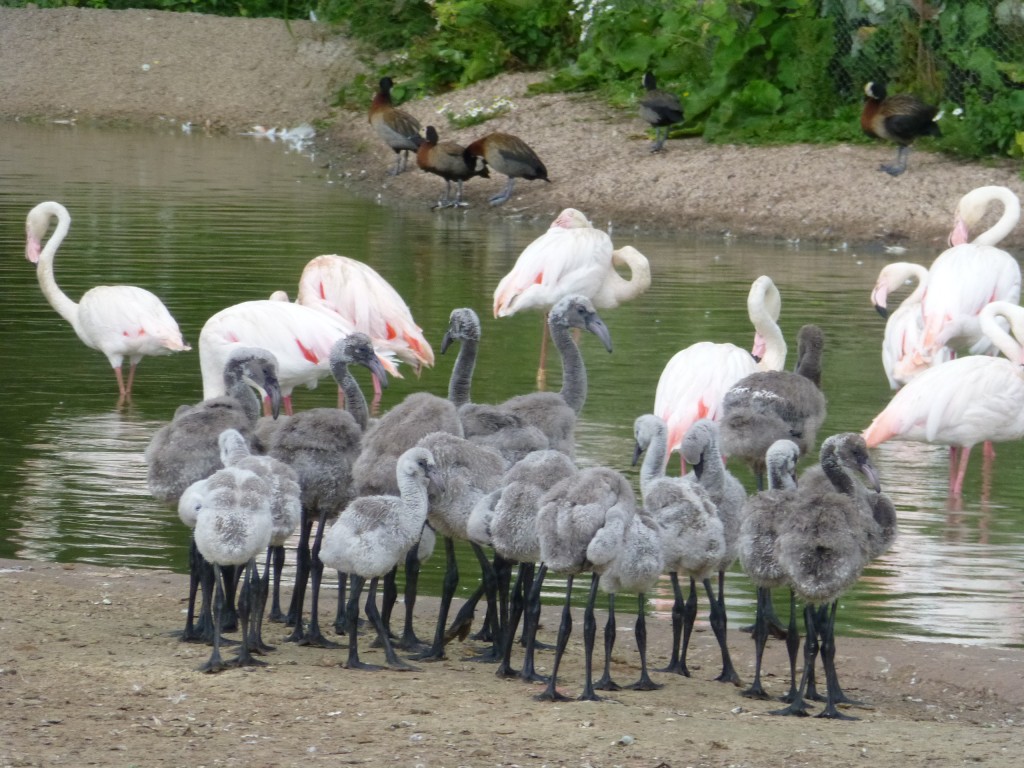
New species success:
African comb duck have not been bred at Slimbridge in over 20 years. The two subspecies of comb duck are broadly similar but for one immediate and striking difference. The South American comb duck male has a pure black flank, with no rippling or inconsistency. The African comb duck male has a pure silver/grey flank. If these subspecies are pure, there should never be any need for misidentification...
We received 3 males and 3 females in early 2013, and these were placed into the Lesser flamingo exhibit to mature. In spring this year the best pair was chosen to go into an off-site breeding aviary, and they were given an array of different nest boxes. Despite the special attention they received the female refused to accept the male, and so it was with great annoyance that I watched the male follow her around to no avail. It looked like a hopeless situation, and so you can imagine my glee when we eventually discovered that the remaining pairs in the Grounds had laid! Phil and I have witnessed Comb ducks breeding in Madagascar, and Phil in particular observed how females will command the attention of many males before making breeding decisions. It could prove that the competition between males is actually a recipe for breeding success with this species, and that a comfortable single-occupancy aviary is not their favourite scenario. It was Duane who eventually came across the nest; a most fantastic creation within such a nasty rotten box...
There are 23 eggs here; far too many for a single bird to have lain. It seems certain that both females contributed to this bounty, and we caught them at the point of incubation. These were transported post-haste to an Rcom incubator where they could be incubated safely. No single bird could possibly incubate such a monstrous clutch. In addition both females would want to sit, and so this anticipated competition could have risked success. Of the 23, 12 proved fertile. This suggests to me that one female had the dominant male mating with her, and the other female had the subordinate male who proved infertile. This is all guesswork though. It could be that both females are represented here, and that would be great indeed. These 12 beauties will hopefully help guarantee that we see African comb duck at WWT for another 20 years...
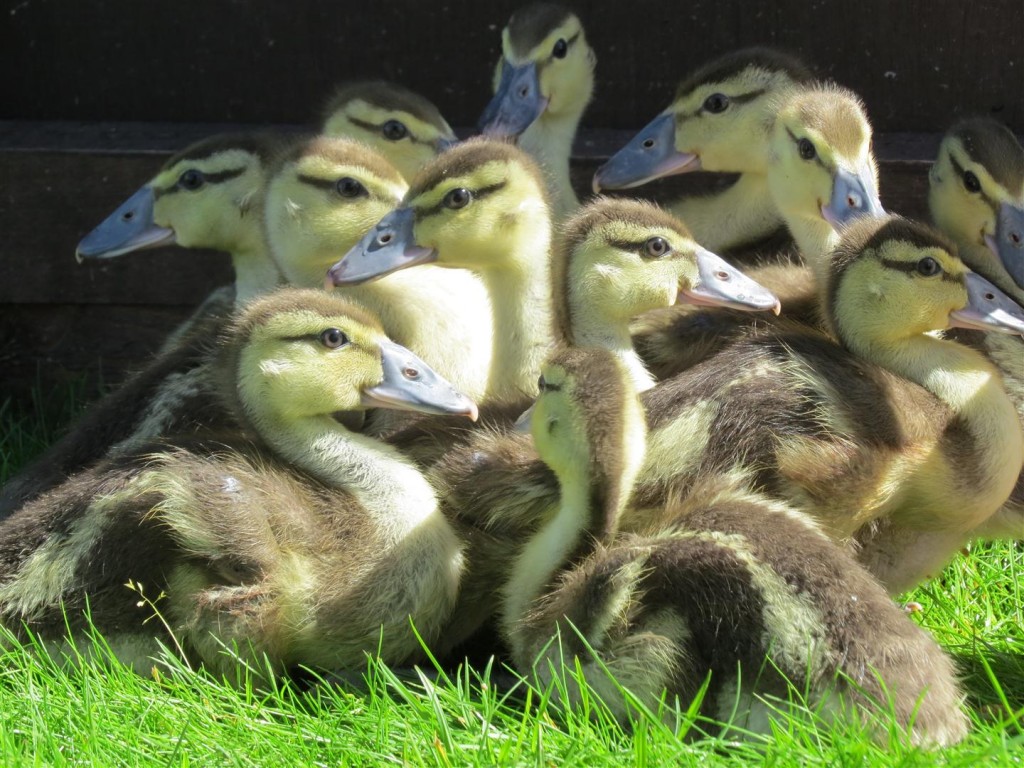
Black-necked swan rearing:
These cheeky swans are a bit of a success story for the Duckery this season following a small tragedy at the Arundel Wetland Centre. After a successful incubation period, the Arundel team lost their breeding female a couple of days after the cygnets had hatched. Sam Halpin and the team worked hard to give the pair round the clock care, but without a formal Duckery set-up the two of them found themselves in staff bathrooms! To minimise the time needed to rear them, the two were transported to Slimbridge in order for them to make some friends!
Initially, the Ruddy headed geese weren’t too keen on the fluffballs they had been offered, but they quickly learnt that they were very comfortable pillows at night! The geese showed the swans how to find water, how to graze and where to snooze under the heat lamp. In return the swans drained their water drinker, sat in their food, and generally got in the way! Despite their characteristics clashing in every way, everyone rubbed along just fine.
The swans have proven to be very good natured, showing exceptional quality considering that they were hand reared. At WWT we always try to parent-rear swans where possible because we believe as a rule that cygnets require a level of care from their parents that just cannot be re-created by hand. They are slow-growing and weighty, and so where under parental care they would be transported about and led directly to food; these two had to make their own way. Thankfully their Ruddy-headed gosling friends have allowed them to retain a healthy relationship with humans; proving neither fearful nor attracted to human contact. I sincerely hope that these two may prove huge assets to the Trust in the coming years. I look forward to seeing them mature.
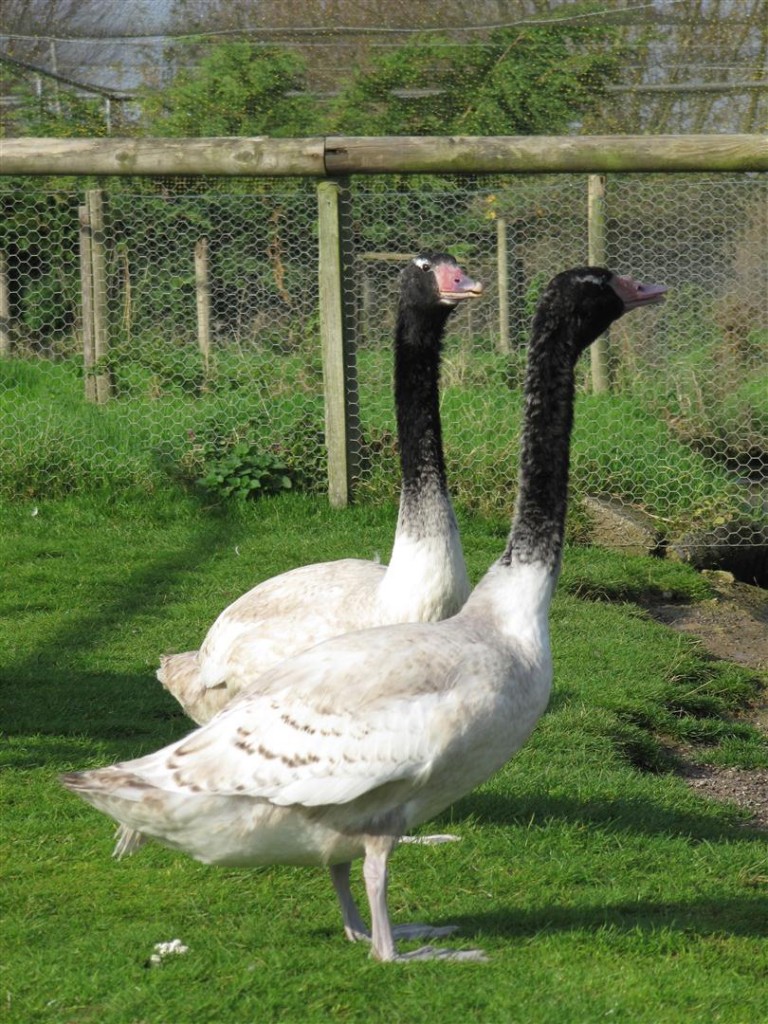
Conservation:
This season the Duckery team was proud to contribute to another project with the fantastic Nigel Jarrett and team. The Aquaponics project, placed on the site of the old Crane rearing facility, is investigating the viability of a water filtration system that could potentially be used to great effect on other projects such as the Madagascan Pochard #teampoch. In advance of a Baers Pochard Action Plan, the Conservation department received 3 clutches of captive Baers eggs from Slimbridge and Martin Mere. These have been hatched and reared in a Balai-approved bio-secure facility. Here these birds can be observed and documented in the hope that this information might one day prove invaluable to any future projects. These activities continue to support WWT in its Conservation initiative and we are proud to remain supportive in our contributions.
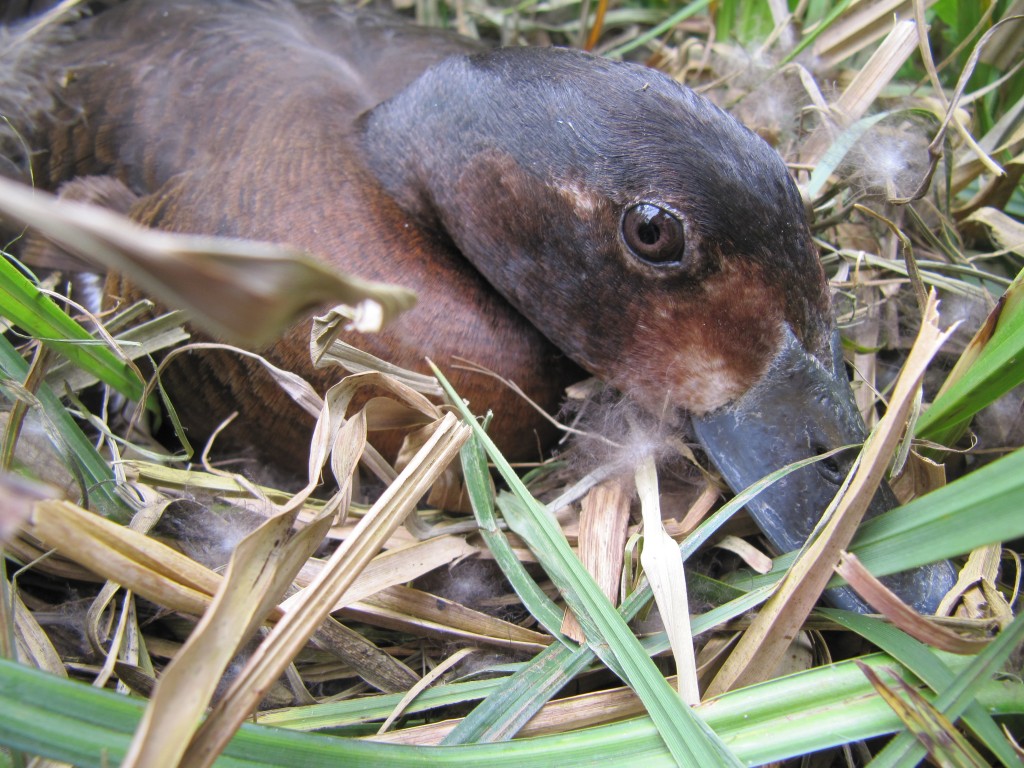
This Autumn period we also contributed toward EAZA’s studbook programme for the White-winged duck. When I first started full-time back in 2007 we only had 6 or 7 white-wings, and the outlook looked pretty bleak for them in captivity. We called in several loans made to other institutions over the years, and we began to place pairs into breeding pens. I made a spreadsheet (minimal!) and planned their genetic future. Since those first efforts WWT Slimbridge and Llanelli have bred 6 in 2008, 5 in 2009, 12 in 2010, 18 in 2012 plus three acquisitions, 4 in 2013 plus 2 acquisitions, 17 in 2014 plus 2 acquisitions, and 14 in 2015. The WWWD studbook programme is now looking fantastic, and my spreadsheet is huge! Progeny of loaned birds have already been acquired by European zoos through BIAZA, but this time we were in a position to make a direct donation by sending 1.1 to Cologne Zoo. We are very proud to see so many of this species in zoos and collections once again. The species has forever been on a rollercoaster and their future will never be certain. They are a prime example of a species that could decline overnight and whose captive population could one day prove vital.
Breeding difficulties: With certain species we are approaching minimum species breeding thresholds and have been attempting to increase numbers. Species such as Koloa (Hawaiian duck,) American Wigeon, white-backed duck and Cape shoveler are all close to just 10 individuals and need their numbers boosting. Other species such as the North American black duck have also taken a dive, with just 8 currently on site. Because these species are so critical within WWT they are not currently on show. We have taken remedies to improve our situation with these groups by acquiring 1.1 new white-back and 2.2 new American wigeon this winter. Concerning the Cape shoveler and Koloa, we will have new birds reaching breeding age in 2016 which will hopefully help in their regard. It is important to highlight that whilst we as an organisation that is foremost a Conservation Education facility for the value of wetlands and their occupants, we are also partly responsible for the continuation of species in captivity. It would be a sad day indeed when a species was irretrievably lost. Working with captive birds will forever be an aid and tool to understanding our interpretation of wild populations, and this value cannot be highlighted enough.
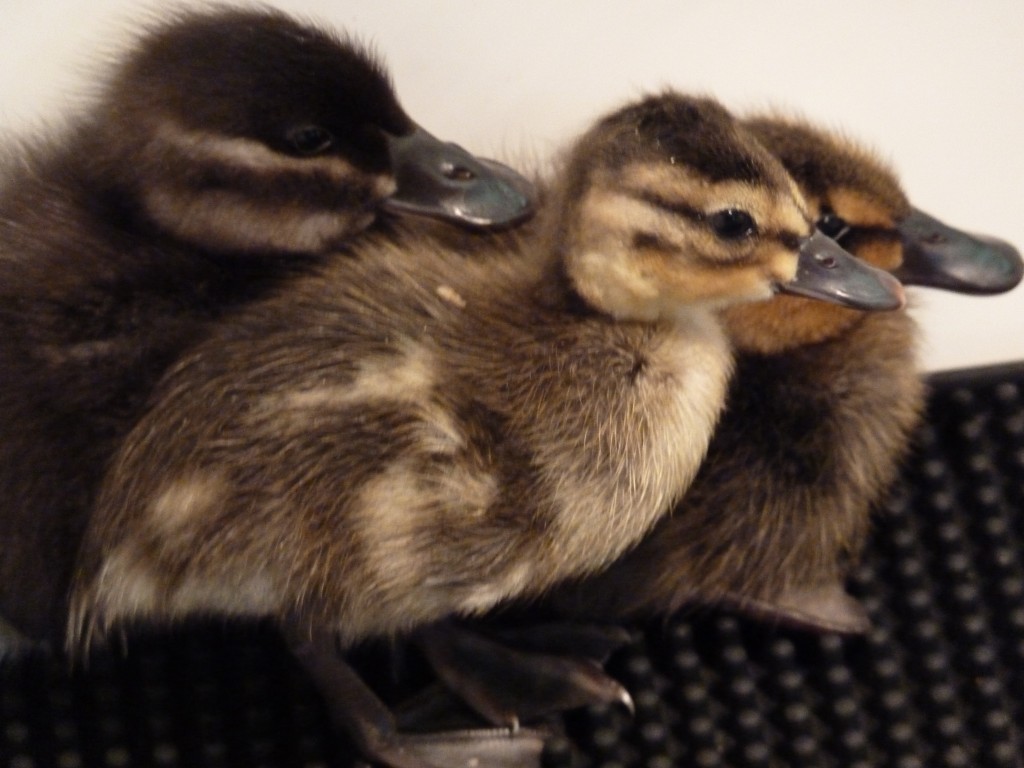
Methodology: The 2015 season was another well managed season. WWT didn’t over produce, and species were hatched and timed well so groups could mature and grow evenly throughout the summer months. Centres communicated well and we were all able to be aware of totals in the other Duckery facilities. As a result nearly all of the birds are pre-allocated to other centres and are looking in great health. This all comes as a culmination of good pairings, good aviaries, good nest management, good egg transport, good incubator room procedures good rearing techniques, and above all, great teamwork. We continue to hold some historical surplus which we are slowly re-distributing as collections demand.
Downy Duckling days: These were simplified but remained essentially within the similar format seen in previous years. Poor weather kept numbers low on some days but the feedback was very good overall, with people choosing to compliment us as well as joke around and coo over the “fluffies!” Huge thanks go out to the volunteers that help and support the staff during this busy period, and take such pains to learn and share the information. This short period is very intense, and one of the only periods where the Duckery area is open to professionals and visitors alike.
Summary: A very productive season overall, with some quality highlights. We were particularly happy to breed successfully from a newly acquired male Maccoa who sired 10 ducklings by 2 females. We bred Ruff for the first time, producing a cracking little bird which was genetically tested and identified to be female. A pair of Koloa/Hawaiian duck was produced from dumped eggs, which will be invaluable to such a small population and will join our bumper crop from 2012.
As a team we keep on improving, with enhanced understanding of one another as well as increased communication, but the year could never run as smoothly as it does without our cracking team of volunteers. I should like to take this opportunity and on behalf of the team to thank our regulars; Jen Sudworth, Heledd Smith, Nick Bayston and Jethro Jarrett. Huge thanks also go out to our seasonal volunteers; Electra, Rhiannon, Ali, Alice and Julia. You have all been a joy to train and work with, and your support is invaluable.
